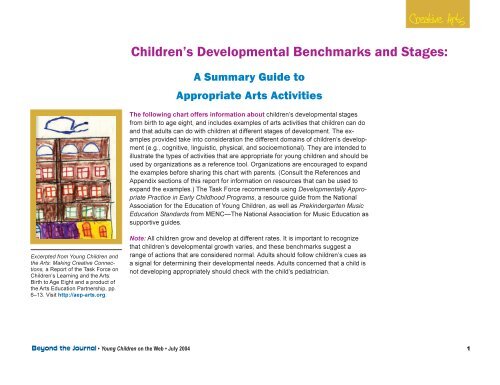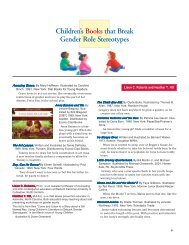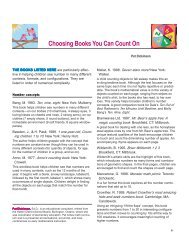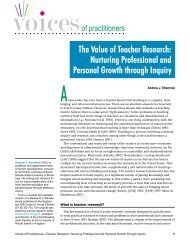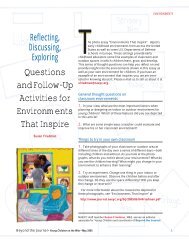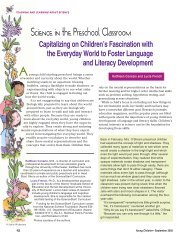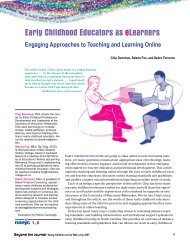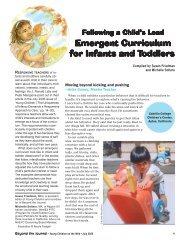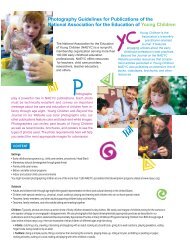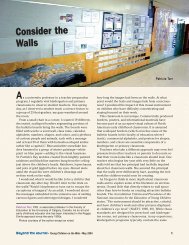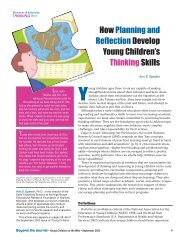Children's Developmental Benchmarks and Stages
Children's Developmental Benchmarks and Stages
Children's Developmental Benchmarks and Stages
You also want an ePaper? Increase the reach of your titles
YUMPU automatically turns print PDFs into web optimized ePapers that Google loves.
Excerpted from Young Children <strong>and</strong><br />
the Arts: Making Creative Connections,<br />
a Report of the Task Force on<br />
Children’s Learning <strong>and</strong> the Arts:<br />
Birth to Age Eight <strong>and</strong> a product of<br />
the Arts Education Partnership, pp.<br />
6–13. Visit http://aep-arts.org.<br />
A Summary Guide to<br />
Appropriate Arts Activities<br />
The following chart offers information about children’s developmental stages<br />
from birth to age eight, <strong>and</strong> includes examples of arts activities that children can do<br />
<strong>and</strong> that adults can do with children at different stages of development. The examples<br />
provided take into consideration the different domains of children’s development<br />
(e.g., cognitive, linguistic, physical, <strong>and</strong> socioemotional). They are intended to<br />
illustrate the types of activities that are appropriate for young children <strong>and</strong> should be<br />
used by organizations as a reference tool. Organizations are encouraged to exp<strong>and</strong><br />
the examples before sharing this chart with parents. (Consult the References <strong>and</strong><br />
Appendix sections of this report for information on resources that can be used to<br />
exp<strong>and</strong> the examples.) The Task Force recommends using <strong>Developmental</strong>ly Appropriate<br />
Practice in Early Childhood Programs, a resource guide from the National<br />
Association for the Education of Young Children, as well as Prekindergarten Music<br />
Education St<strong>and</strong>ards from MENC—The National Association for Music Education as<br />
supportive guides.<br />
Note: All children grow <strong>and</strong> develop at different rates. It is important to recognize<br />
that children’s developmental growth varies, <strong>and</strong> these benchmarks suggest a<br />
range of actions that are considered normal. Adults should follow children’s cues as<br />
a signal for determining their developmental needs. Adults concerned that a child is<br />
not developing appropriately should check with the child’s pediatrician.<br />
Creative Arts<br />
Children’s <strong>Developmental</strong> <strong>Benchmarks</strong> <strong>and</strong> <strong>Stages</strong>:<br />
Beyond the Journal • Young Children on the Web • July 2004 1
Young babies<br />
<strong>Stages</strong><br />
When babies are awake, they can be<br />
nurtured through sights, sounds <strong>and</strong><br />
gentle touches.<br />
Babies should stay calm <strong>and</strong> in a<br />
regular routine (e.g., don’t let babies<br />
cry for long periods of time).<br />
Holding, cradling, <strong>and</strong> hugging will<br />
nurture babies <strong>and</strong> develop their<br />
sense of touch <strong>and</strong> space.<br />
Young babies show pleasure by looking<br />
intently, joyful smiling <strong>and</strong> laughing,<br />
arm <strong>and</strong> leg movements, <strong>and</strong> other<br />
gestures.<br />
Ages<br />
birth to 3 months<br />
3 to 8 months<br />
Examples of What Children Do<br />
During This Stage<br />
• Sleeping, sucking, grabbing, staring,<br />
listening, crying, <strong>and</strong> making small<br />
movements.<br />
• Use facial expressions such as smiling<br />
<strong>and</strong> frowning to express their needs.<br />
• Respond to voices, both loud <strong>and</strong> soft<br />
tones, by turning their heads <strong>and</strong><br />
moving their arms <strong>and</strong> legs.<br />
• Respond to people’s voices by turning<br />
their head <strong>and</strong> eyes.<br />
• Vocalize with some intonation <strong>and</strong><br />
begin making repetitive sounds.<br />
• Respond to objects <strong>and</strong> people they<br />
can see <strong>and</strong> touch, <strong>and</strong> voices <strong>and</strong><br />
music they can hear.<br />
• Make meaningful noises, coo, <strong>and</strong><br />
babble.<br />
• Respond to friendly <strong>and</strong> angry tones of<br />
others’ voices.<br />
• Will begin to be able to roll over <strong>and</strong> sit<br />
upright by the end of this stage.<br />
Sample Arts Experiences That<br />
Promote Learning<br />
• Stimulate eye movement <strong>and</strong> auditory<br />
development through contrasting<br />
images (e.g., black <strong>and</strong> white or<br />
colored objects) <strong>and</strong> voices (speaking<br />
or singing).<br />
• Increase awareness of space,<br />
movement, <strong>and</strong> sound by hanging<br />
mobiles, playing soothing music, <strong>and</strong><br />
making animated faces. Babies<br />
discover that they can change what<br />
they see, hear, <strong>and</strong> touch.<br />
Continue previous experiences as well<br />
as the following:<br />
• Encourage recognition of new aspects<br />
in the environment by touching<br />
objects, <strong>and</strong> hearing adults name<br />
them, <strong>and</strong> observing functions.<br />
• Stimulate innate sense of discovery<br />
through music <strong>and</strong> movement, through<br />
shaking a rattle, or swaying to the<br />
notes of a violin, flute, or guitar (or<br />
other music).<br />
• Build vocal skills through stories <strong>and</strong><br />
songs; encourage expression by<br />
making faces, gestures, <strong>and</strong> sounds.<br />
Creative Arts<br />
What Adults <strong>and</strong> Children Can<br />
Do Together in the Arts<br />
• Watch for babies’ cues <strong>and</strong> signals,<br />
such as a response to music <strong>and</strong><br />
objects (cues include smiles <strong>and</strong><br />
reaching).<br />
• Allow babies to hear soothing music,<br />
birds singing, water babbling, <strong>and</strong><br />
other soft sounds.<br />
• Hang mobiles within a foot of the eye<br />
line. Sing, talk, <strong>and</strong> read books to<br />
babies.<br />
• Use gentle movement when holding<br />
babies (e.g., rocking <strong>and</strong> swaying).<br />
Continue previous experiences as well<br />
as the following:<br />
• Begin to place rattles or appropriate<br />
toys with textures <strong>and</strong> sounds in<br />
babies’ fists.<br />
• Encourage babies to reach <strong>and</strong> sway<br />
arms.<br />
• Use appropriate soft <strong>and</strong> colorful<br />
materials for babies to touch (e.g.,<br />
blankets or toys).<br />
• Use vocal sounds to express feelings,<br />
such as happy <strong>and</strong> surprised.<br />
• Encourage babies to laugh <strong>and</strong> smile<br />
by rhyming, singing, <strong>and</strong> using pat-acake<br />
type gestures.<br />
• Use nap time to read nursery rhymes<br />
<strong>and</strong> sing lullabies.<br />
Beyond the Journal • Young Children on the Web • July 2004 2
Crawlers <strong>and</strong> walkers<br />
<strong>Stages</strong><br />
Crawlers <strong>and</strong> walkers are able to see<br />
<strong>and</strong> begin to know how things work.<br />
They experiment with their world <strong>and</strong><br />
use their senses to underst<strong>and</strong><br />
everything by touching, seeing,<br />
hearing, etc.<br />
They also need extra attention <strong>and</strong><br />
supervision (especially as they begin<br />
to crawl <strong>and</strong> walk). They need<br />
someone to talk to them about what<br />
they see <strong>and</strong> hear.<br />
Ages<br />
8 to 18 months<br />
Examples of What Children Do<br />
During This Stage<br />
• Experience new senses of adaptation<br />
<strong>and</strong> anticipation (e.g., through hide<strong>and</strong>-seek,<br />
peek-a-boo).<br />
• Become more deliberate <strong>and</strong> purposeful<br />
in responding to people <strong>and</strong><br />
objects.<br />
• Comprehend simple words <strong>and</strong><br />
intonation of language (such as “all<br />
gone,” <strong>and</strong> “bye-bye”).<br />
• Begin speaking <strong>and</strong> actively experiment<br />
with their voice.<br />
• Can follow simple instructions,<br />
especially with visual or vocal cues.<br />
• Hold large crayons, move them<br />
between h<strong>and</strong>s, <strong>and</strong> make marks on<br />
paper.<br />
• Can place blocks one on top of the<br />
other.<br />
• Demonstrate continuous vocabulary<br />
growth up to 30 words.<br />
• Crawl, pull self up, walk, climb, <strong>and</strong><br />
may begin to run.<br />
• Actively show affection <strong>and</strong> express<br />
positive <strong>and</strong> negative feelings.<br />
Sample Arts Experiences That<br />
Promote Learning<br />
Continue previous experiences as well<br />
as the following:<br />
• Encourage imitation of voices, sounds,<br />
<strong>and</strong> movements.<br />
• Expose them to different sounds <strong>and</strong><br />
movements that others make.<br />
• Allow exploration of the different<br />
sounds they can make with their voice<br />
or by clapping their h<strong>and</strong>s.<br />
• Teach motor skills by using simple<br />
musical instruments such as toy drums<br />
<strong>and</strong> xylophones.<br />
• Teach repetition of patterns in voice,<br />
movement, <strong>and</strong> sounds as well as<br />
texture <strong>and</strong> colors in images <strong>and</strong><br />
objects.<br />
• Develop balance by simple dance<br />
movements while sitting or st<strong>and</strong>ing.<br />
Creative Arts<br />
What Adults <strong>and</strong> Children Can<br />
Do Together in the Arts<br />
Continue previous experiences as well<br />
as the following:<br />
• Move to different play areas to see<br />
nature, people, <strong>and</strong> images. Talk about<br />
what the children see.<br />
• Play music <strong>and</strong> move the children’s<br />
feet, legs, <strong>and</strong> h<strong>and</strong>s to the beat.<br />
• Explore shapes <strong>and</strong> colors of everyday<br />
objects (e.g., clothing, cereal boxes,<br />
etc.). Talk about what is around them<br />
<strong>and</strong> make up songs to go with what<br />
they see <strong>and</strong> hear.<br />
• Hang pictures at eye level. Name,<br />
describe, <strong>and</strong> point to items in the<br />
pictures.<br />
• Use character voices <strong>and</strong> gestures<br />
when reading stories.<br />
• Provide opportunities to explore safe<br />
<strong>and</strong> appropriate media in visual arts<br />
(e.g., finger-painting with water,<br />
drawing with crayons).<br />
Beyond the Journal • Young Children on the Web • July 2004 3
Toddlers<br />
<strong>Stages</strong><br />
Toddlers move quickly <strong>and</strong> with greater<br />
skill during this phase. They begin<br />
teaching themselves <strong>and</strong> learn from<br />
watching other children.<br />
Words become associated with<br />
movement <strong>and</strong> accompanying body<br />
sensations.<br />
Identity becomes an important issue<br />
during this stage, tied to increasing<br />
independence.<br />
Toddlers become increasingly coordinated<br />
in their movements <strong>and</strong><br />
gestures at this time.<br />
Language development increases<br />
rapidly, <strong>and</strong> they begin counting up to<br />
five.<br />
They develop an interest in other<br />
children <strong>and</strong> being near them.<br />
They begin developing an interest in<br />
pretend play.<br />
Ages<br />
18 to 24 months<br />
24 to 36 months<br />
Examples of What Children Do<br />
During This Stage<br />
• Copy others’ actions <strong>and</strong> voices, speak<br />
in two-word (short) sentences, name<br />
objects, <strong>and</strong> can look at books on their<br />
own.<br />
• Build thoughts, mental pictures, <strong>and</strong><br />
verbal labels associated with learned<br />
concepts.<br />
• Can st<strong>and</strong> on tiptoes, catch a ball with<br />
arms <strong>and</strong> chest, <strong>and</strong> walk up <strong>and</strong> down<br />
stairs.<br />
• Unbutton large buttons, <strong>and</strong> unzip<br />
large zippers.<br />
• Begin to match <strong>and</strong> sort <strong>and</strong> learn<br />
where objects belong.<br />
• Show curiosity <strong>and</strong> recognize<br />
themselves in a mirror or photograph.<br />
• Demonstrate vocabulary growth up to<br />
approximately 200 words.<br />
• Use words to express feelings.<br />
• Develop symbolic thought <strong>and</strong> build<br />
mental concepts or mental pictures.<br />
• Make first representational drawings.<br />
• Engage in self-directed imaginative play.<br />
• Listen, repeat, <strong>and</strong> experiment with<br />
words on an increasing basis. Speak<br />
in sentences with three or more words.<br />
• Underst<strong>and</strong> self in relation to others.<br />
• Can paint with large brush <strong>and</strong> tear paper.<br />
Sample Arts Experiences That<br />
Promote Learning<br />
Continue previous experiences as well<br />
as the following:<br />
• Children learn to make aesthetic<br />
choices such as what color to paint the<br />
sky <strong>and</strong> what songs they like to sing.<br />
• Encourage imagination <strong>and</strong> pretending<br />
by prompting children to move like a<br />
cat through a jungle or dance like an<br />
imaginary character to music.<br />
• Build vocabulary through drama, role<br />
playing, <strong>and</strong> acting out stories (with<br />
puppets or pictures). Acting out stories<br />
also generates questions <strong>and</strong> allows<br />
for multiple answers.<br />
• Learn about feelings through songs,<br />
poems, <strong>and</strong> stories.<br />
Continue previous experiences as well<br />
as the following:<br />
• Develop problem solving skills <strong>and</strong><br />
empathy by predicting what will happen<br />
next <strong>and</strong> pretending to be favorite<br />
characters in books, stories, or songs.<br />
• Help to develop analytical skills by<br />
listening <strong>and</strong> responding to music,<br />
poems, drama games, <strong>and</strong> looking at<br />
visual art <strong>and</strong> describing the details.<br />
Creative Arts<br />
What Adults <strong>and</strong> Children Can<br />
Do Together in the Arts<br />
Continue previous experiences as well<br />
as the following:<br />
• Activities with items as simple as a<br />
paper plate, nontoxic paint, <strong>and</strong> playdough<br />
are appropriate. Allow children<br />
to explore <strong>and</strong> experiment with<br />
materials (with supervision).<br />
• While listening to music, dance <strong>and</strong><br />
move while holding their h<strong>and</strong>s.<br />
• While dressing children, pretend socks<br />
are puppets or animals.<br />
• Recreate children’s favorite stories or<br />
routines.<br />
• Build a library of books <strong>and</strong> take<br />
weekly trips to the local library.<br />
• Show <strong>and</strong> tell stories from photographs.<br />
• Have simple musical/percussion<br />
instruments available to play.<br />
• Visit children’s museums <strong>and</strong> appropriate<br />
child-friendly exhibits <strong>and</strong> performances.<br />
Continue previous experiences as well<br />
as the following:<br />
• Continue to build on experiences in<br />
music, drama, dance, <strong>and</strong> art <strong>and</strong> make<br />
arts-based activities a daily routine.<br />
• Incorporate singing, storytelling, <strong>and</strong><br />
dance into daily experiences (e.g.,<br />
eating lunch, nap time, <strong>and</strong> saying<br />
good-bye). Identify shapes, textures,<br />
<strong>and</strong> colors in foods <strong>and</strong> clothing.<br />
Beyond the Journal • Young Children on the Web • July 2004 4
Toddlers (cont’d)<br />
Preschoolers<br />
<strong>Stages</strong><br />
Preschoolers’ strengths <strong>and</strong> motor skills<br />
along with their more adult-like body<br />
proportions allow greater opportunities<br />
to explore the world.<br />
Children can count to five <strong>and</strong> higher<br />
during this stage.<br />
They start to play with other children<br />
<strong>and</strong> are more likely to share.<br />
They are generally more cooperative<br />
<strong>and</strong> enjoy new experiences.<br />
Ages<br />
24 to 36 months<br />
(cont’d)<br />
Examples of What Children Do<br />
During This Stage<br />
• Complete a form puzzle with large knobs.<br />
• Begin to turn pages one at a time.<br />
• Can repeat representative gestures<br />
<strong>and</strong> motions such as “Itsy, Bitsy<br />
Spider,” or “I’m a Little Teapot.”<br />
3 to 4 years • Ask many questions, mainly those that<br />
begin with “why.”<br />
• Talk about things <strong>and</strong> make up stories.<br />
• Print large capital letters using pencil<br />
or crayon.<br />
• Cut figures with scissors, <strong>and</strong> may be<br />
able to print first name.<br />
• Push <strong>and</strong> pull a wagon.<br />
• Attempt to get dressed on their own.<br />
• Gain a sense of direction <strong>and</strong> relationship<br />
to others’ space.<br />
• Begin to show social skills <strong>and</strong> manners.<br />
• Can match shapes, colors, <strong>and</strong> patterns.<br />
• Can draw faces with some detail.<br />
• With direction, can play group games<br />
such as “Ring Around the Rosey,” <strong>and</strong><br />
musical chairs.<br />
Sample Arts Experiences That<br />
Promote Learning<br />
• Promote physical development <strong>and</strong><br />
self-confidence through dance <strong>and</strong><br />
creative movement. Children learn how<br />
to use different parts of their body to<br />
express themselves.<br />
• Drawing, painting, games, <strong>and</strong> songs<br />
promote different concepts such as<br />
loud <strong>and</strong> quiet, hard <strong>and</strong> soft, light <strong>and</strong><br />
dark, etc.<br />
• By stringing beads or drawing on<br />
paper, h<strong>and</strong> coordination is developed.<br />
Continue previous experiences as well<br />
as the following:<br />
• Contribute to the child’s ability to learn<br />
causality. New problems pose questions<br />
<strong>and</strong> encourage children to seek their<br />
own answers <strong>and</strong> act on choices.<br />
• Help develop language skills by<br />
reciting poems <strong>and</strong> finger plays.<br />
Number skills are developed through<br />
music (e.g., counting rhythm <strong>and</strong> beats<br />
when playing a musical instrument).<br />
• Dance helps to build motor control,<br />
body relationships, <strong>and</strong> directionality.<br />
• Spatial acuity is developed through<br />
drawing, sculpting, <strong>and</strong> other visual arts.<br />
• Social skills are encouraged by group<br />
activities such as learning dance steps<br />
or singing songs.<br />
Creative Arts<br />
What Adults <strong>and</strong> Children Can<br />
Do Together in the Arts<br />
• Tell <strong>and</strong> act out family stories about gr<strong>and</strong>parents,<br />
aunts <strong>and</strong> uncles, <strong>and</strong> others.<br />
• Assist children in using brushes <strong>and</strong><br />
paint <strong>and</strong> mold objects with clay.<br />
• Create simple costumes for drama <strong>and</strong><br />
theater activities (e.g., dress-up in old<br />
clothes).<br />
• Take children to child-friendly museums,<br />
libraries, <strong>and</strong> live performances<br />
to introduce them to different aspects<br />
of their community.<br />
Continue previous experiences as well<br />
as the following:<br />
• Pantomime characters from books read with<br />
children. Ask them to guess characters.<br />
• Imitate movements made by objects (such<br />
as cars) <strong>and</strong> other people (such as drivers).<br />
• Construct collages using paper, glue,<br />
scissors, <strong>and</strong> magazine cut outs. Talk<br />
with them about the collage or create a<br />
story together.<br />
• Hum tunes to familiar songs <strong>and</strong> allow<br />
children to add the lyrics that go with<br />
the melody.<br />
• Allow children to observe themselves in the<br />
mirror while dancing or acting out a story.<br />
• Bring small groups of children to<br />
interactive performances <strong>and</strong> exhibits.<br />
Beyond the Journal • Young Children on the Web • July 2004 5
Preschoolers (cont’d)<br />
<strong>Stages</strong><br />
Preschoolers learn greatly from<br />
interaction with others. They begin to<br />
underst<strong>and</strong> that they have feelings<br />
<strong>and</strong> opinions that are different from<br />
others.<br />
Children at this stage are more likely to<br />
underst<strong>and</strong> <strong>and</strong> remember the<br />
relationships, concepts, <strong>and</strong> strategies<br />
that they acquire through firsth<strong>and</strong>,<br />
meaningful experiences.<br />
They have longer attention spans <strong>and</strong><br />
enjoy activities that involve exploring,<br />
investigating, <strong>and</strong> stretching their<br />
imagination.<br />
School-age children<br />
School-age children are able to make<br />
conscious decisions about art, music,<br />
dance, <strong>and</strong> theater <strong>and</strong> respond to<br />
them with feelings <strong>and</strong> emotion.<br />
They learn to compare <strong>and</strong> contrast different<br />
sounds, pictures, <strong>and</strong> movements.<br />
They become increasingly skilled at<br />
creating their own art, songs, stories,<br />
<strong>and</strong> dance movements.<br />
Since children learn in an integrated<br />
fashion, it is vital that their learning<br />
experiences incorporate multiple<br />
domains of development including<br />
cognitive, physical, <strong>and</strong> socioemotional.<br />
Ages<br />
4 to 5 years<br />
Examples of What Children Do<br />
During This Stage<br />
• Can copy simple geometric figures, dress<br />
self, <strong>and</strong> use more sophisticated utensils.<br />
• Use language to express thinking <strong>and</strong><br />
increasingly complex sentences in<br />
speaking to others. Express their own<br />
feelings when listening to stories.<br />
• Enjoy using words in rhymes <strong>and</strong> underst<strong>and</strong><br />
nonsense <strong>and</strong> using humor.<br />
• Can be very imaginative <strong>and</strong> like to<br />
exaggerate.<br />
• Say <strong>and</strong> begin writing the alphabet.<br />
• Can identify what is missing from a<br />
picture (such as a face without a nose.)<br />
• Can identify basic colors.<br />
• Have better control in running, jumping,<br />
<strong>and</strong> hopping but tend to be clumsy.<br />
5 to 8 years • Have good body control for doing<br />
cartwheels <strong>and</strong> better balance for<br />
learning to ride a bike.<br />
• Play jump rope <strong>and</strong> hop scotch.<br />
• Can build inventive model buildings<br />
from cardboard <strong>and</strong> other materials.<br />
• Begin spelling, writing, <strong>and</strong> enjoy telling<br />
stories to other children <strong>and</strong> adults.<br />
• Become increasingly independent <strong>and</strong><br />
will try new activities on their own.<br />
Sample Arts Experiences That<br />
Promote Learning<br />
Continue previous experiences as well<br />
as the following:<br />
• Strengthen nonverbal, cognitive skills<br />
by encouraging children to describe<br />
people in their world using pictures,<br />
body movements, <strong>and</strong> mime.<br />
• Provide creative outlets for prereading<br />
skills through activities such as making<br />
up stories, reciting poems, <strong>and</strong> singing<br />
songs with puppets <strong>and</strong> stuffed animals.<br />
• Children begin to make observations by<br />
role-playing human <strong>and</strong> animal characters<br />
in a variety of imaginary settings.<br />
• Memory is strengthened by repeating<br />
stories, poems, <strong>and</strong> songs.<br />
• By using clay or other art supplies,<br />
children learn to make choices <strong>and</strong><br />
how to make things happen.<br />
Continue previous experiences as well<br />
as the following:<br />
• Children will learn many ways of using<br />
their own language to tell stories. This<br />
can be encouraged by telling folktales<br />
<strong>and</strong> stories through pantomime,<br />
drawing, <strong>and</strong> music.<br />
• Through the artistic process, children<br />
learn what works <strong>and</strong> what doesn’t.<br />
They also learn how to think about<br />
making choices when experiencing<br />
music, dance, theater, <strong>and</strong> art.<br />
• Children develop higher levels of thinking<br />
by learning to look at others’ artwork or<br />
performances <strong>and</strong> developing an opinion.<br />
Creative Arts<br />
What Adults <strong>and</strong> Children Can<br />
Do Together in the Arts<br />
Continue previous experiences as well<br />
as the following:<br />
• Discover with children how the body<br />
can move to music <strong>and</strong> the difference<br />
when there is no music.<br />
• Create music with children using empty<br />
containers as drums. (Empty plastic<br />
containers filled with beans <strong>and</strong> rice<br />
can serve as maracas, for example.)<br />
• Make a patchwork quilt with scraps of materials<br />
sewn together with yarn. Create <strong>and</strong><br />
illustrate stories based on the quilt.<br />
• Encourage children to assume roles of family<br />
members or literary figures in improvisations.<br />
Base them on children’s experiences,<br />
family customs, books, or songs.<br />
• Recreate drawings from favorite books.<br />
Continue previous experiences as well<br />
as the following:<br />
• Represent familiar actions like making<br />
pizza <strong>and</strong> doing chores in creative<br />
movement <strong>and</strong> dance activities. Allow<br />
the child to choose movements <strong>and</strong><br />
ask the reasons for those choices.<br />
• Write <strong>and</strong> recite poetry <strong>and</strong> paint<br />
pictures that depict themes such as<br />
nature, school, <strong>and</strong> family. Ask<br />
questions <strong>and</strong> encourage discussion.<br />
• Exhibit children’s artwork, <strong>and</strong> hang it<br />
so others can look at <strong>and</strong> respond to it.<br />
• Make scrapbooks or portfolios to keep<br />
favorite stories, photos, <strong>and</strong> artwork.<br />
• When discussing music, art, dance,<br />
<strong>and</strong> theater, children can talk in terms • Collect tapes <strong>and</strong> recordings of music <strong>and</strong><br />
of likes <strong>and</strong> dislikes. This builds<br />
encourage children to select favorites.<br />
Beyond the Journal • Young Children on the Web • July 2004 judgment <strong>and</strong> analytical skills.<br />
• Encourage improvisation <strong>and</strong> stories, <strong>and</strong> 6<br />
provide materials that offer imaginary props.


